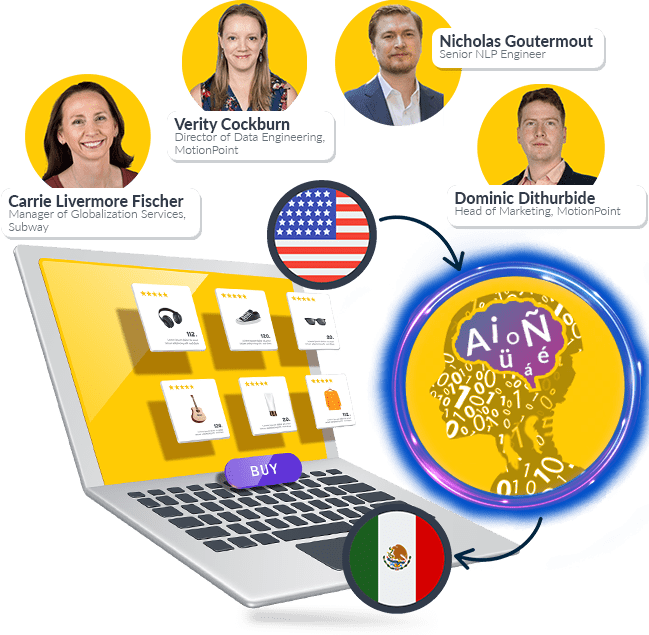Did you know? Ninety percent of consumers believe that videos aid in the decision-making process. Yet only 20% of the world’s population speaks English. To truly reach an international audience, you need to create content in multiple languages. In fact, Latin America, Europe, the Middle East, and Africa (EMEA) make up the largest portion of video consumers worldwide—not North America. If your videos are only available in English, you could be missing out on reaching the majority of potential customers.
Fortunately, creating multilingual video content is easier than it sounds. Through localization, you can alter existing videos to better serve local and international viewers and expand your reach. Read on to learn more about the video localization process and the business benefits it offers.
What Is Video Localization?
Video localization is the process of adapting video content to meet the linguistic and cultural preferences of a target audience.
It involves tailoring every element of the video to ensure the message resonates with the local culture. That may include:
- Creating captions and subtitles.
- Replacing the existing audio with dubbing.
- Recording voiceover in the target language.
- Synchronizing and editing visuals to match the new audio.
- Translating metadata such as title tags and meta descriptions.
Once complete, a localized video may feature all of these elements or just a few. The extent to which you need to adapt it will depend on several factors including: the type of content, target audience, desired quality, and budget. A video localization service provider can offer guidance on how to best adapt your video content, but it helps to understand each element before you hire one.
Elements of Video Localization
Below is a brief overview of the five key features of video localization.
Captions and Subtitles
The terms captions and subtitles are often used interchangeably. Yet both serve a distinct purpose for viewers.
Captions are words that are superimposed at the bottom of the video to communicate speech, non-speech sounds, and music that are necessary for understanding the content. Non-speech is indicated with brackets to differentiate it from dialog. This additional information assists viewers who are deaf or hard of hearing. Like subtitles, captions can be translated into multiple languages.
Subtitles are text translations of spoken audio. They don’t include non-speech sounds or music unless they’re part of the dialog. Subtitles aren’t appropriate for deaf or hard of hearing viewers, and may not meet disability rights laws in some countries.
Although some video hosting platforms such as YouTube can produce automatic captions or subtitles, they aren't always accurate. Nor can these platforms localize content for the target audience. In contrast, a video localization provider will edit the original script to ensure accuracy and cultural relevance.
Despite the additional cost, captions and subtitles alone are more affordable than dubbing or voiceover. They can also be combined with either method to significantly improve engagement. According to the video-on-demand platform Uscreen, adding captions or subtitles:
- Increases average rates of viewing to completion from 61% to 91%.
- Boosts video shares by 15%.
- Produces 17% better reactions.
- Increases call-to-action click throughs by 26%.
Dubbing
Audio dubbing is the process of replacing the original dialog with audio in the target language. This method works best for videos that feature more than one talking head and/or two or more people engaging in conversation. The goal is to replace the dialog as precisely and organically as possible, which includes matching mouth movements and speech patterns. This often requires re-writing lines of dialog or editing the video to better fit the target language.
Because dubbing requires trained voice actors, the process is more expensive than subtitling. However, here are a few scenarios where you may need to dub the audio:
- Instructional videos that include visual aids. It can be difficult for viewers to switch between reading subtitles and looking at the images.
- Videos that target young children and/or audiences who have low literacy rates. Viewers who have lower reading levels will struggle to follow subtitles.
- Launching in markets where dubbing is the norm. This will help enhance the feeling that the video was tailored to that audience.
Voiceovers
Voiceover is a recording of a person's offscreen commentary or narration during a video. It requires translating the original video, recording the script in the target language, and editing it on top of the new video. Voiceover works best for videos that either rely on narration or feature only one speaker.
Traditionally, producing voiceovers involves hiring a voice actor to record the script in a sound booth. This method is expensive and is typically reserved for high value projects. Today, voiceovers can be produced using artificial intelligence (AI). The AI platform isolates voices in the video, translates them into the target language, and creates synthetic voiceovers that sound like human speech.
Compared to dubbing, voiceover is less precise because it doesn't need to match a speaker's mouth movements or facial expressions. It's also faster and cheaper because it only requires one voice actor.
Metadaten
Metadata is information about the video that is used to label and categorize its content. Dies umfasst:
- Meta title, or the title that appears in search results.
- Meta description, or the description that appears in search results.
- Tags, or keywords that tell search engines what the video is about.
- Transcript and sitemap, which help search engines index the video.
Localizing elements of the video’s metadata will improve its search engine ranking in the target language and help drive more traffic from the target audience.
Video Localization Tips: Developing a Strategy
Given all the elements involved, we recommend developing a video localization strategy before adapting any content. Below are a few tips to get started.
Consider Cultural Sensitives When Scripting
Before you write the script for a multilingual video, consider the cultural norms of each target audience. Avoid jokes or cultural references that could be difficult to translate and/or easy to misinterpret. Remember, what is acceptable in one culture may be offensive in another.
Be Mindful of On-Screen Text
On-screen graphics with text are difficult to adjust because each graphic must be redesigned to fit the language of the target audience. To make the localization process easier, create a style guide that keeps the language simple and limits the number of words on screen.
Limit Number of Speakers
Limiting the number of speakers in a video will keep localization costs down. As you plan the video, consider using off-screen voiceover or limit the use of on-screen speakers to reduce costs and minimize dubbing issues.
Plan Ahead for Subtitles and Captions
Leave space for subtitles and captions within the video. We recommend placing the text at the bottom third of the frame. When you position it here, the text will only cover a small portion of the on-screen actions. This keeps the user's eye from moving too far away from the focal point of the video.
Video Localization vs. Video Translation
Now, you may be thinking video localization sounds similar to video translation. So, why do you need to localize a video instead of simply translating it? Here are a three key reasons:
- Video localization involves adapting content to the cultural norms of the target market. That may include re-writing the script, altering graphics and images, or even re-filming the video. Video translation, on the other hand, involves reproducing the script and text elements in the target language and doesn't always account for cultural differences.
- Video localization may require multiple types of translation such as website translation to adapt the pages where the video is hosted. Or it may require transcreation to adapt the video’s message to the target market.
- Video translations are often performed using an artificial intelligence (AI) platform. Although AI can produce a quality translation, it can't account for cultural nuances. Unlike translation, video localization requires input from subject matter experts who can produce a culturally authentic final product.
(For more on the topic, check out our article on localization vs. translation.)
Benefits of Video Localization
While video translation alone serves an important purpose, video localization will help you make the greatest impact with multilingual content. Let's take a look at three major benefits.
Enhances International SEO Efforts
According to a 2021 Cisco forecast, as much as 81% of web traffic comes from videos. By localizing video content, you’ll:
- Drive more web traffic to your multilingual websites.
- Win more backlinks, which boost your ranking.
- Improve user experience (UX) and average time on page.
- Increase conversions.
Multilingual videos can also help you gain valuable organic real estate on search engine page results (SERPs). Localized videos allow you to take advantage of different language variant searches for the related query.
Reinforces International Brand Image
Given their popularity, multilingual videos are a great way to get your brand in front of a global audience. Localization ensures that any video you produce-regardless of language-reinforces an authentic brand image. This helps increase awareness and drive revenue in global markets.
Increases Accessibility
Captions and subtitles make video content accessible for audiences who are deaf or hard of hearing, regardless of culture. They also allow viewers to watch with the sound off. According to a Verizon Media survey, 50% of respondents watch videos with the sound off, and 29% said captions make videos easier to understand—even with the sound off.
Expand Your Global Reach with Video Localization Today
As you can see, video localization is one of the best ways to reach new audiences, drive web traffic, and build brand recognition worldwide. However, tackling it on your own can be a difficult and time-consuming task. That’s why we’re here to help. MotionPoint is a localization company that can localize your video content quickly and affordably.
Want to learn more about how MotionPoint can take your multilingual video strategy to the next level? Contact us today!
Letzte Aktualisierung: 23. Juni 2022



